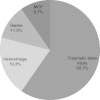Mortality in severely injured elderly patients: a retrospective analysis of a German level 1 trauma center (2002-2011)
- PMID: 25248489
- PMCID: PMC4237949
- DOI: 10.1186/s13049-014-0045-3
Mortality in severely injured elderly patients: a retrospective analysis of a German level 1 trauma center (2002-2011)
Abstract
Background: Demographic change is expected to result in an increase in cases of severely injured elderly patients. To determine special considerations in treatment and outcome, patients aged 75 years and older were studied.
Methods: All patients in the included age group with an Injury Severity Score (ISS) ≥ 16 upon primary admission to hospital between July 2002 and December 2011 were included in this mortality analysis. The data used for this study was gained partly from data submitted to the German Trauma Register and partly from patients' hospital records. A comparison between survivors and decedents was performed, as well as age-adjusted and ISS-adjusted analyses. The odds ratio and relative risk were used to determine predictors for mortality.
Results: One-hundred eight patients met the inclusion criteria. The overall mortality proportion was 57.4%. The decedents were more severely injured (ISS 26 vs. 20, p < 0.001) and suffered more severe head traumas (GCS 4 vs. 12, p < 0.001; AIS head 5 vs. 4, p = 0.006). No differences were found in vital parameters measured at the accident scene or trauma room. Decedents had deranged coagulation with a prolonged PTT (41.1 sec vs. 27.6 sec, p = 0.008) and reduced prothrombin ratio (66.5% vs. 82.8%, p = 0.016).
Conclusions: The treatment of severely injured elderly patients is challenging. The most common cause of accident is falling from less than 3 m with head injuries being determinant. We identified deranged coagulopathy as an important predictor for mortality, suggesting rapid normalization of coagulation might be a key to reducing mortality.
Figures






References
-
- https://www.destatis.de/DE/Publikationen/Thematisch/Bevoelkerung/Bevoelk... Bevölkerung - Alter im Wandel - Ältere Menschen in Deutschland und der EU - Statistisches Bundesamt (Destatis).] Accessed April 2014.
-
- Sampalis JS, Nathanson R, Vaillancourt J, Nikolis A, Liberman M, Angelopoulos J, Krassakopoulos N, Longo N, Psaradellis E. Assessment of mortality in older trauma patients sustaining injuries from falls or motor vehicle collisions treated in regional level I trauma centers. Ann Surg. 2009;249:488–495. doi: 10.1097/SLA.0b013e31819a8b4f. - DOI - PubMed
MeSH terms
LinkOut - more resources
Full Text Sources
Other Literature Sources
Medical
Miscellaneous

